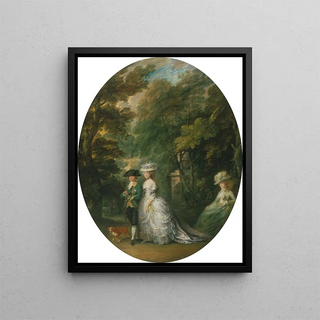Art print | Henri duc de Cumberland 1745-1790 with the Duchess of Cumberland 1743-1798 and Lady Elizabeth Lu - Thomas Gainsborough


View from behind

Frame (optional)
Henri duc de Cumberland 1745-1790 with the Duchess of Cumberland 1743-1798 and Lady Elizabeth Lu - Thomas Gainsborough – Captivating Introduction
In the fascinating world of 18th-century art, Thomas Gainsborough's work stands out for its ability to capture not only faces but also emotions and stories. The art print of Henri duc de Cumberland 1745-1790 with the Duchess of Cumberland 1743-1798 and Lady Elizabeth Lu bears witness to this mastery. Gainsborough, with his unique approach to portraiture, depicts here a scene of palpable intimacy, where the characters seem almost to step out of the frame to engage in a silent dialogue with the viewer. This painting, both majestic and delicate, immerses us in the English aristocracy of the time, revealing nuances of social life and human relationships.
Style and uniqueness of the work
The piece is distinguished by its subtle use of light and color, characteristic of Gainsborough's style. Soft hues and delicate contrasts create an atmosphere that is both warm and refined. The choice of clothing, richly detailed, evokes not only the status of the figures but also the aesthetic taste of the era. The composition, skillfully orchestrated, guides the viewer's gaze through expressive faces and graceful postures of the figures. Every detail, from the draping of the dresses to carefully chosen accessories, contributes to a visual narrative that transcends the simple portrait to become a true scene of life. Gainsborough succeeds here in immortalizing a fleeting moment while leaving a lasting impression on those who contemplate his work.
The artist and his influence
Thomas Gainsborough, born in 1727, is one of the masters of portrait and landscape of his time. His work is marked by an innovative approach that combines realism and romanticism. Gainsborough managed to establish himself in an artistic environment dominated by rigid traditions by injecting a personal and expressive touch into his portraits. His influence is palpable, not only within the framework of English painting but also in the evolution of portraiture across Europe. By redefining the conventions of aristocratic representation, he paved the way for many artists who followed, enabling them to explore

Matte finish

View from behind

Frame (optional)
Henri duc de Cumberland 1745-1790 with the Duchess of Cumberland 1743-1798 and Lady Elizabeth Lu - Thomas Gainsborough – Captivating Introduction
In the fascinating world of 18th-century art, Thomas Gainsborough's work stands out for its ability to capture not only faces but also emotions and stories. The art print of Henri duc de Cumberland 1745-1790 with the Duchess of Cumberland 1743-1798 and Lady Elizabeth Lu bears witness to this mastery. Gainsborough, with his unique approach to portraiture, depicts here a scene of palpable intimacy, where the characters seem almost to step out of the frame to engage in a silent dialogue with the viewer. This painting, both majestic and delicate, immerses us in the English aristocracy of the time, revealing nuances of social life and human relationships.
Style and uniqueness of the work
The piece is distinguished by its subtle use of light and color, characteristic of Gainsborough's style. Soft hues and delicate contrasts create an atmosphere that is both warm and refined. The choice of clothing, richly detailed, evokes not only the status of the figures but also the aesthetic taste of the era. The composition, skillfully orchestrated, guides the viewer's gaze through expressive faces and graceful postures of the figures. Every detail, from the draping of the dresses to carefully chosen accessories, contributes to a visual narrative that transcends the simple portrait to become a true scene of life. Gainsborough succeeds here in immortalizing a fleeting moment while leaving a lasting impression on those who contemplate his work.
The artist and his influence
Thomas Gainsborough, born in 1727, is one of the masters of portrait and landscape of his time. His work is marked by an innovative approach that combines realism and romanticism. Gainsborough managed to establish himself in an artistic environment dominated by rigid traditions by injecting a personal and expressive touch into his portraits. His influence is palpable, not only within the framework of English painting but also in the evolution of portraiture across Europe. By redefining the conventions of aristocratic representation, he paved the way for many artists who followed, enabling them to explore






